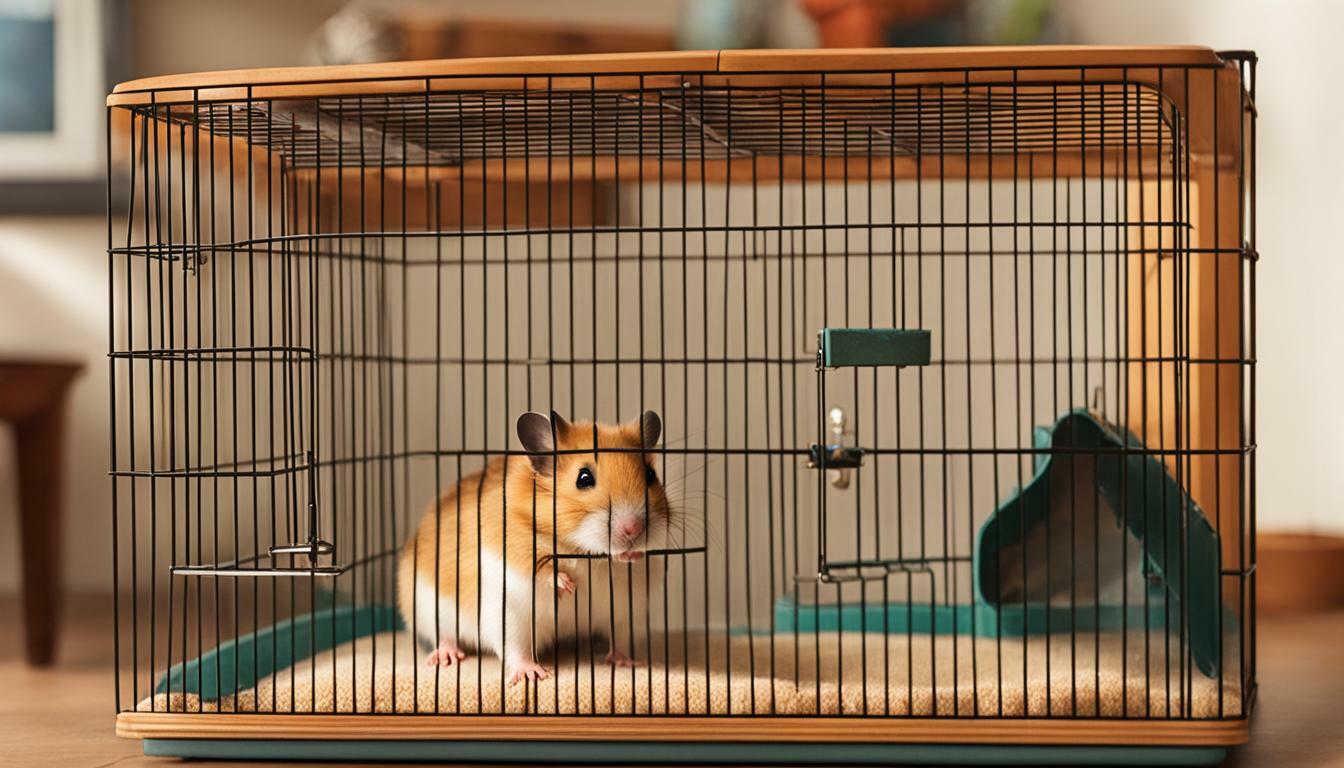If you notice your hamster shaking or trembling, it’s important to understand the possible causes and what steps you can take to help your furry friend. There are several reasons why hamsters may shake, including fear, stress, anxiety, dominance issues, exposure to cold temperatures, or during hibernation. In some cases, shaking may be a sign of an underlying health issue that requires attention. By understanding the potential causes and taking appropriate action, you can provide comfort and support to your hamster.
Key Takeaways:
- Hamsters may shake due to fear, stress, anxiety, dominance issues, cold temperatures, or during hibernation.
- Shaking can also be a symptom of an underlying health issue like a cold, respiratory infection, or nervous system problem.
- To help your hamster, minimize stress factors, gradually introduce changes, and maintain an ideal room temperature.
- Seek veterinary attention if the shaking is severe, frequent, or accompanied by other signs of distress or illness.
- Monitor your hamster closely for any changes in behavior or additional signs of duress.
Reasons for Hamster Shaking
Hamsters can shake for a variety of reasons, ranging from emotional factors like fear and stress to physical factors such as temperature changes. Understanding the reasons behind your hamster’s shaking can help you provide the necessary care and support.
Emotional Factors: Hamsters are small, sensitive creatures and can easily become frightened or stressed. Common triggers for emotional shaking include loud noises, sudden movements, handling that is too rough, or the presence of a predator. Dominance issues can also lead to shaking, as hamsters establish their hierarchy within their social groups.
Physical Factors: Changes in temperature can cause hamsters to shake. If their environment is too cold, they may tremble in an attempt to generate warmth. Similarly, during hibernation, some hamsters may exhibit shaking as their bodies adjust to the lower metabolic rate.
If your hamster’s shaking is severe, frequent, or accompanied by other signs of distress or illness, it’s important to seek veterinary attention. A professional can help determine if there is an underlying health issue causing the shaking and provide appropriate treatment. In the meantime, you can minimize stress factors in your hamster’s environment, gradually introduce changes, and ensure they are kept in an environment with an ideal room temperature.
| Possible Reasons for Hamster Shaking |
|---|
| Fear and stress |
| Anxiety |
| Dominance issues |
| Exposure to cold temperatures |
| Hibernation |
Remember to closely monitor your hamster for any additional signs of distress, illness, or changes in behavior. By providing comfort and support, seeking veterinary attention when necessary, and maintaining a safe and stress-free environment, you can help ensure your hamster’s well-being.
Possible Health Issues
Shaking in hamsters can sometimes be a symptom of underlying health issues, including respiratory infections or nervous system disorders. If your hamster is shaking and not moving, it could indicate a respiratory infection, which may require veterinary attention. Other signs to look out for include difficulty breathing and wheezing. These symptoms can be alarming, but with timely intervention, your hamster can receive the necessary treatment to recover.
Another possible cause of hamster shaking is a nervous system disorder. This can manifest as twitching or jerking movements in addition to shaking. If you notice these symptoms, it’s important to bring your hamster to a veterinarian experienced in exotic pet care. They can conduct a thorough examination and determine the appropriate course of action.
To better understand the cause of your hamster’s shaking, it’s crucial to consider their overall health. If your hamster has been exposed to extreme temperatures or feels cold to the touch, shaking may be a response to the cold environment. Providing a warm and comfortable living space can help alleviate this issue and prevent further shaking episodes.
| Signs of Respiratory Infection | Signs of Nervous System Disorder |
|---|---|
|
|
Remember, if your hamster is exhibiting severe or frequent shaking and any of the mentioned symptoms, it is crucial to seek veterinary attention. They can provide a proper diagnosis and recommend the most appropriate treatment plan.
While it’s important to be aware of potential health issues, it’s also essential to create a stress-free environment for your hamster. Minimize loud noises, sudden changes, and potential stressors in their habitat. Gradually introduce any changes to their surroundings, such as new toys or cage setups, to allow them time to adjust without becoming overwhelmed.
By closely monitoring your hamster’s behavior and providing them with comfort and support, you can help them navigate any health issues and create a safe and happy living environment.
Minimizing Stress Factors
Creating a stress-free environment is crucial to helping your hamster feel secure and reducing the likelihood of shaking. Hamsters are sensitive creatures, and certain factors can trigger stress and anxiety in them. By minimizing these stress factors, you can help your hamster maintain a calm and healthy disposition.
Factors That Can Cause Stress in Hamsters
- Loud noises: Loud noises can startle and stress hamsters. Try to keep your hamster’s habitat in a quiet area of your home, away from sources of loud sounds.
- Excessive handling: While it’s important to interact with your hamster, too much handling can be overwhelming for them. Give your hamster some alone time to rest and relax.
- Inconsistent routines: Hamsters thrive on routine, so try to establish a consistent schedule for feeding, playtime, and cleaning their habitat.
- Uncomfortable habitat: Ensure that your hamster’s habitat is comfortable, with appropriate bedding, a hiding spot, and enough space to move around.
By addressing these stress factors, you can create a calm and safe environment for your hamster, minimizing the likelihood of shaking. Remember to observe your hamster closely and seek veterinary attention if the shaking persists or if you notice any other signs of distress or illness in your furry friend.
| Signs of Stress in Hamsters: |
|---|
| “Flattened” body posture |
| Excessive grooming |
| Loss of appetite |
| Aggressive behavior |
| Increased urination |
“Creating a stress-free environment is crucial to helping your hamster feel secure and reducing the likelihood of shaking.”
Remember, each hamster is unique, and it may take some trial and error to identify the specific stress factors affecting your pet. Be patient and observant, and provide your hamster with the care and attention it needs to thrive in a stress-free environment.
Gradually Introducing Changes
Making changes to your hamster’s habitat or routine can be done effectively by introducing them slowly over time. This allows your hamster to adjust and adapt without feeling overwhelmed or stressed. Whether you’re adding new toys to their cage or making adjustments to their environment, taking a gradual approach is key.
One way to introduce changes slowly is by adding one new item or making one small adjustment at a time. This allows your hamster to become familiar with each change before moving on to the next. For example, if you want to add a new toy to their cage, start by placing it outside the cage for a few days so they can investigate and become accustomed to its presence. Then, gradually introduce the toy inside the cage, placing it near their regular hiding spot or play area.
Another helpful tip is to maintain consistency in their routine while making changes. Hamsters thrive on routine and can become stressed if their daily habits are disrupted. Try to introduce changes during a time when their routine is already somewhat flexible, such as during their waking hours. This way, they can explore and adjust to the changes without feeling too disoriented.
Remember to observe your hamster’s behavior during the transition period. Are they showing signs of stress or discomfort? Are they avoiding the new item or area entirely? If so, it may be necessary to take a step back and slow down the introduction process. Each hamster is unique, and some may require more time to adjust than others.
Table: Tips for Gradually Introducing Changes
| Tips | Description |
|---|---|
| Introduce one change at a time | Add or adjust one thing before moving on to the next to prevent overwhelming your hamster. |
| Start with familiarization | Place new items outside the cage initially, allowing your hamster to investigate before introducing them inside. |
| Maintain consistency | Keep their routine as consistent as possible while making changes to minimize stress and provide a sense of stability. |
| Observe their behavior | Pay attention to any signs of stress or discomfort and adjust the pace of the introduction accordingly. |
By taking a gradual approach when introducing changes to your hamster’s habitat or routine, you can help them feel more comfortable and reduce the likelihood of shaking or other signs of distress. Remember, each hamster is unique, so be patient and attentive to their individual needs throughout the process. Your hamster will thank you for it!
Maintaining Ideal Room Temperature
Ensuring the room where your hamster lives is kept at an appropriate temperature is essential for their well-being and can prevent shaking episodes. Hamsters are highly sensitive to temperature changes, and extremes in temperature can cause them stress and discomfort. In general, the ideal room temperature for hamsters is between 65 and 75 degrees Fahrenheit (18-24 degrees Celsius).
To maintain a suitable environment for your hamster, consider the following:
- Place your hamster’s cage away from direct sunlight and drafts, as these can result in rapid temperature fluctuations that could disturb their equilibrium.
- Use a thermometer to monitor the temperature regularly, especially during the winter months when indoor heating can cause rooms to become too warm.
- If the room temperature drops below the recommended range, you can provide additional warmth by using a heating pad or a small heat lamp. Just make sure it is placed outside of the cage and does not come into direct contact with your hamster.
“Maintaining a consistent and comfortable room temperature will help keep your hamster happy and healthy.”
Remember, each hamster may have slightly different temperature preferences, so it’s essential to observe your pet’s behavior and make adjustments accordingly. If your hamster is shaking despite being in an appropriate temperature range, it’s crucial to explore other potential causes, such as stress or health issues. Always consult with a veterinarian if you have concerns about your hamster’s well-being.
| Temperature Range (Fahrenheit) | Temperature Range (Celsius) | Hamster Comfort Level |
|---|---|---|
| 65-75°F | 18-24°C | Optimal |
| Below 65°F | Below 18°C | Too Cold |
| Above 75°F | Above 24°C | Too Warm |
Seeking Veterinary Attention
If your hamster’s shaking persists, worsens, or is accompanied by other worrying symptoms, it is crucial to consult a veterinarian for a proper diagnosis. While some shaking in hamsters can be attributed to stress or environmental factors, persistent or severe shaking may indicate an underlying health issue that requires professional attention.
A veterinarian can conduct a thorough examination of your hamster to determine the cause of the shaking. They may perform tests, such as blood work or x-rays, to rule out or identify any potential health concerns. Additionally, a veterinarian can provide appropriate treatment and guidance to help alleviate your hamster’s distress and promote their overall well-being.
| Signs that warrant veterinary attention: |
|---|
| Severe or frequent shaking |
| Difficulty breathing |
| Lethargy or lack of movement |
| Loss of appetite |
| Unusual discharge from eyes, nose, or mouth |
Remember, as a pet owner, you play a crucial role in monitoring your hamster’s health and well-being. While seeking veterinary attention is important, it’s equally important to be observant and take note of any changes in behavior or physical symptoms. This information can be valuable for the veterinarian in determining the proper course of action.
You are your hamster’s advocate and caretaker, and by seeking veterinary attention when needed, you can ensure that your furry friend receives the necessary care and treatment to overcome any health challenges they may be facing.
Monitoring Closely for Signs of Duress
It’s important to keep a close eye on your hamster’s overall well-being and behavior to detect any potential issues beyond just shaking. Hamsters are small and delicate creatures, and any changes in their behavior can be a sign of underlying problems. So, how can you monitor your hamster closely?
1. Observe their daily activities: Take note of your hamster’s eating habits, water consumption, and activity levels. Any significant changes, such as a loss of appetite or decreased energy, could indicate an underlying issue.
2. Pay attention to physical symptoms: Look out for any signs of distress, such as rapid breathing, twitching, or difficulty moving. These symptoms, when combined with shaking, may indicate a more serious health problem that requires immediate attention.
3. Create a daily routine: Establishing a regular routine for your hamster can help you identify any deviations from their normal behavior. Monitor their sleep schedule, grooming habits, and interactions with toys or cage mates. Any disruptions or unusual behavior may warrant further investigation.
| Tip: | Keep a journal or a log to record your observations. This can help you track any patterns or changes in behavior over time. |
|---|
Remember, your hamster’s well-being is your top priority. By closely monitoring their behavior and promptly addressing any issues, you can ensure they live a happy and healthy life.
Addressing Specific Health Issues
If a specific health issue is identified as the cause of your hamster’s shaking, taking appropriate steps to address that condition is vital. Let’s explore some common health issues that can cause shaking in hamsters and how to manage them:
Respiratory Infections
Respiratory infections are a common ailment among hamsters and can manifest as shaking along with symptoms like sneezing, coughing, and breathing difficulties. If you suspect your hamster has a respiratory infection, it’s crucial to consult a veterinarian. They may prescribe antibiotics or recommend nebulization treatments to alleviate symptoms and help your hamster recover.
Nervous System Problems
Shaking can also be a sign of a nervous system problem in hamsters. If your hamster’s shaking is accompanied by uncoordinated movements, twitching, or difficulty walking, it’s important to seek veterinary attention. A veterinarian will perform a thorough examination and may recommend further diagnostic tests to identify and address the underlying issue.
Colds
If your hamster is experiencing frequent shaking, it could be a result of a cold. Just like humans, hamsters can catch colds too. To help your hamster recover, provide a warm and cozy environment, and avoid exposing them to drafts. You can also offer nutritious foods and ensure they have access to fresh water. If the symptoms persist or worsen, consulting a veterinarian is recommended.
Remember, if you suspect any of these health issues or notice any other signs of distress or illness in your hamster, it’s always best to consult a veterinarian. They will provide the appropriate diagnosis and treatment plan to ensure the well-being of your pet.
| Common Health Issues | Treatment |
|---|---|
| Respiratory Infections | Antibiotics, nebulization treatments |
| Nervous System Problems | Thorough examination, diagnostic tests |
| Colds | Warm environment, nutritious food, fresh water |
Providing Comfort and Support
When your hamster is experiencing shaking episodes, offering them comfort and support can help them feel safe and secure. Just like humans, hamsters can get scared or stressed, and providing a calm and nurturing environment can make a big difference in their well-being.
One way to provide comfort is by offering a warm and cozy hiding spot for your hamster. This can be a small hut or a cozy corner in their cage where they can retreat to when they feel anxious. Adding soft bedding material like shredded paper or tissues can make it even more comfortable for them.
In addition to a cozy hiding spot, gentle reassurance can go a long way in comforting your hamster. Talking softly to them and offering gentle strokes can help them feel more at ease. It’s important to be patient and understanding with your hamster, giving them the time they need to calm down.
| Ways to Provide Comfort and Support: |
|---|
| 1. Warm and Cozy Hiding Spot: Offer a small hut or a cozy corner in their cage with soft bedding material. |
| 2. Gentle Reassurance: Talk softly to your hamster and offer gentle strokes to help them feel secure. |
Remember, every hamster is unique, and what works for one may not work for another. It’s important to observe your hamster’s behavior and adjust your approach accordingly. If you notice that your hamster’s shaking episodes persist or worsen despite your efforts to provide comfort and support, it’s best to consult a veterinarian for further guidance.
Preventive Care for Hamster Health
Regular preventive care, including a balanced diet, proper hygiene, and timely check-ups, can contribute to your hamster’s long-term health and reduce the risk of shaking. By following these simple practices, you can ensure that your furry friend stays happy and healthy.
Diet and Nutrition
A well-balanced diet is crucial for your hamster’s overall well-being. Provide a variety of fresh fruits, vegetables, and high-quality pellets as the main source of nutrition. Avoid feeding them sugary or fatty foods, as these can lead to obesity and other health issues. Additionally, ensure that fresh water is always available.
Hygiene and Cleanliness
Hamsters are known to be clean animals, but they still require regular grooming and a clean living environment. Provide them with a dust-free bedding material and regularly clean their cage to prevent the buildup of bacteria and ammonia. Additionally, trim their nails and brush their fur to keep them looking their best.
Veterinary Check-ups
Regular visits to the vet are vital for monitoring your hamster’s health and catching any potential issues early on. Your vet can perform a thorough examination, check for signs of disease, and provide necessary vaccinations. They can also offer guidance on any specific health concerns or questions you may have.
| Care Tips | Frequency |
|---|---|
| Check-ups with the vet | Every 6-12 months |
| Cage cleaning | Weekly |
| Grooming and nail trimming | As needed |
| Monitoring food and water supply | Daily |
By implementing these preventive care practices, you can help ensure that your hamster leads a happy and healthy life. Remember to always provide a safe and stress-free environment, and if you notice any unusual behavior, seek veterinary assistance promptly. Your furry friend deserves the best care, and by taking proactive measures, you can minimize the risk of shaking and other health issues.
Conclusion
Understanding the possible causes of your hamster’s shaking and taking appropriate action can help ensure their comfort and overall health. If you notice your hamster shaking, it could be a result of fear, stress, anxiety, or dominance issues. Environmental factors like exposure to cold temperatures or hibernation can also lead to shaking. Additionally, shaking may be a symptom of an underlying medical condition such as a cold, respiratory infection, or nervous system problem.
To provide the best care for your hamster, there are several steps you can take. Start by minimizing stress factors in their environment. Provide a secluded and comfortable habitat and avoid sudden changes. Gradually introduce changes, such as new toys or cage setups, to help your hamster adjust without becoming overwhelmed.
It’s important to maintain an ideal room temperature for your hamster to prevent shaking caused by exposure to cold temperatures. Ensure that their habitat is neither too hot nor too cold.
If the shaking is severe or frequent, it is crucial to bring your hamster to the vet. A professional can properly diagnose any underlying health issues and provide the necessary treatment. Additionally, closely monitoring your hamster for other signs of distress, illness, or changes in behavior is essential.
Taking preventive measures to maintain your hamster’s overall health and well-being can also minimize the occurrence of shaking episodes. Providing comfort and support during episodes of shaking, such as offering a warm and cozy hiding spot or gentle reassurance, can help your hamster feel safe and secure.
In conclusion, understanding the potential causes of your hamster’s shaking and addressing them promptly can make a significant difference in their quality of life. By creating a stress-free environment, seeking veterinary attention when necessary, and providing comfort and support, you can ensure the well-being of your beloved furry friend.
FAQ
What should I do if my hamster is shaking?
If your hamster is shaking, there are several possible reasons for this behavior. It could be due to fear, stress, anxiety, dominance issues, exposure to cold temperatures, or during hibernation. In some cases, shaking may be a symptom of an underlying medical condition. To help your hamster, you can minimize stress factors, gradually introduce changes, maintain an ideal room temperature, and bring your hamster to the vet if the shaking is severe or frequent.
What are the reasons for hamster shaking?
Hamsters may shake due to fear, stress, anxiety, dominance issues, exposure to cold temperatures, or during hibernation.
Could hamster shaking be a sign of health issues?
Yes, shaking in hamsters can be a symptom of health issues such as respiratory infections, colds, or nervous system problems.
How can I minimize stress factors for my hamster?
To minimize stress factors for your hamster, provide a secluded and comfortable habitat, avoid sudden changes, and maintain a consistent routine.
How can I gradually introduce changes to my hamster’s environment?
You can gradually introduce changes to your hamster’s environment by slowly introducing new toys or cage setups, allowing them time to adjust without becoming overwhelmed.
What is the ideal room temperature for my hamster?
It’s important to maintain an ideal room temperature for your hamster to prevent shaking caused by exposure to cold temperatures. The recommended temperature range is typically between 65-75 degrees Fahrenheit.
When should I seek veterinary attention for my hamster’s shaking?
If your hamster’s shaking is severe, frequent, or accompanied by other signs of distress or illness, it is important to seek veterinary attention.
How closely should I monitor my hamster for signs of duress?
It is important to monitor your hamster closely for any additional signs of distress, illness, or changes in behavior.
How can I address specific health issues that may be causing my hamster’s shaking?
Specific health issues such as a cold, respiratory infection, or nervous system problem should be addressed by bringing your hamster to a veterinarian for proper diagnosis and treatment.
What can I do to provide comfort and support for my shaking hamster?
You can provide comfort and support for your shaking hamster by offering a warm and cozy hiding spot, gentle reassurance, and a calm environment.
Are there any preventive measures I can take to maintain my hamster’s health?
Yes, you can take preventive measures to maintain your hamster’s overall health and well-being, such as providing a balanced diet, regular exercise, and a clean living environment.




